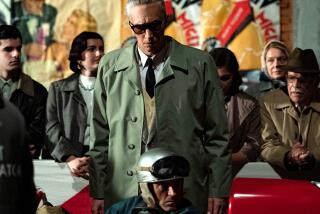Velocita dell’arte
- Share via
Florence, Italy — Tourists who come to the capital of the Italian Renaissance can become so overwhelmed by beauty that they are thrown into a hysterical state known as Stendhal’s syndrome, named after the French novelist who, in 1817, was so unmanned by Giotto’s ceiling frescoes in Santa Croce he could barely walk home.
Stendhal, needless to say, was kind of high maintenance.
For the record:
12:00 a.m. Feb. 12, 2004 For The Record
Los Angeles Times Thursday February 12, 2004 Home Edition Main News Part A Page 2 National Desk 1 inches; 44 words Type of Material: Correction
Maserati -- In an article in Wednesday’s Highway 1 about the 2005 Maserati Quattroporte, the automaker’s emblem was erroneously described as a crown. In fact, the emblem depicts a trident, modeled after a famous statue of the mythical god Neptune found in Bologna, Italy.
But maybe I shouldn’t talk. When I first saw the 2005 Maserati Quattroporte sedan in Tokyo a few months ago, I just about keeled over. This, ladies and gentlemen, is one sensational-looking motorcar, 16.7 feet of automotive aristocracy whose sinuous lines start at the front bumper and continue right up the back of your neck.
Warm, rich, quietly grand, the car -- designed by blue-chip Italian coach builder Pininfarina -- has this wonderful sense of inevitability about it. Although it won’t arrive in the United States until September, the Quattroporte (“four doors,” if you haven’t already parsed it) seems as if it’s been around forever, an instant classic.
You’ve got to love Italian sculpture that can go 170 mph.
Well, I say it’s Italian, but it’s got a goodly dose of Southern California in it too. The lead designer on the Quattroporte project was Ken Okuyama (also designer of the Ferrari Enzo), who left Pininfarina in 2000 to teach at his alma mater, the Art Center College of Design in Pasadena. The design was refined by Okuyama’s Art Center classmate Frank Stephenson, who before becoming design coordinator for Ferrari-Maserati was the pen behind the BMW Mini. (In case you didn’t know, Ferrari acquired Maserati in the late 1990s.)
The design brief called for a prestige sedan -- you may say “executive saloon” if you clench your teeth in that just-so Old Greenwich way -- more than 5 meters in length, which provides plenty of room to be graceful.
The history of the Quattroporte is checkered. Cars with the name were produced at the red-brick factory on Viale Ciro Menotti in Modena from 1963 to 2001, the best of them being the Quattroporte I, Series 2, designed by Pietro Frua. The original Quattroporte took advantage of two facts: first, that the modern Italian autostrada system was becoming functional, creating a market for high-performance saloon cars; second, that Maserati had a superb four-cam, all-alloy V-8 engine it could easily adapt to the purpose, as it had for the 5000 GT coupe.
What is it about the new Quattroporte? First, the tone-perfect grille, stately, sincere and ineffably Old Europe, with horizontal chrome strakes embellished with the Maserati crown. Second, the harmonious proportions, with a ratio of length to wheelbase of 1.64:1, very close to the Pythagorean “golden section.” Third, the gently rising shoulder line, a sine wave of increasing amplitude playing out front to back that gives the silhouette a propulsive energy. Fourth, its sports-car width, more than 75 inches, which accounts for the car’s terrific, predatory stance, the big wheels clutched by flared fenders.
If gazelles being chased by lions had rearview mirrors, the view would be much the same.
The width also contributes to the car’s staggering lateral grip. Maserati says the Quattroporte generates 1.12 g on the skid pad -- that is, on a circular pad of asphalt, the car can orbit with more sideways force than the force of gravity (32 feet per second squared). If this number holds up, it could be a record for a sedan.
Maserati can’t afford to hold back. It’s generally understood that the company made a comprehensive hash of its latest relaunch in the United States in 2001 and 2002, when Maserati introduced the Giugiaro-designed Coupe and Spyder. Although these are very fine cars, their styling causes less Stendhal’s syndrome than dropsy.
The Quattroporte takes the hardware from the Coupe and Spyder and deploys it in a much more desirable package. The engine is the same 4.2-liter, 32-valve V-8, with phased-intake cam timing, producing 400 horsepower at 7,000 rpm and 332 pound-feet of torque at 4,500 rpm. In the Quattroporte, the engine exhales from huge quad exhaust pipes that look as if they might fire tear gas canisters.
Because the designers had 5 meters of overall length to work with, the engine could be situated well back in the bay, behind the front “axle” (the line between the front-wheel center points). It places the heaviest component of the car nearer the center for a lower polar moment, which is to say the car turns more freely, like a spinning ice skater with her arms clutched to her chest.
And, like the Coupe and Spyder, the Quattroporte uses a six-speed transaxle with electrohydraulic gear selector -- a racing gearbox. This arrangement places the next-heaviest component, the transmission, in the rear, balancing the weight of the engine, giving the Quattroporte an excellent 47/53 front-to-rear weight distribution.
You might have guessed, what with all this delicate balancing of masses, racing gearboxes and the like, that the Quattroporte is a high-performance car. Oh, yeah. Zero to 60 mph clicks by in 5.2 seconds and the car is just getting warmed up. Stomp the pedal as if you’re making Lambrusco: The six-speed manual can change ratios as fast as 0.2 second, helping you to ratchet through the forward gears fast enough to stay ahead of the building power.
Top speed is supposed to be 170 mph, and I don’t doubt it. On a four-lane stretch of autostrada, the A12 from Pisa to Rosignano, I saw 155 mph and the car was still pulling in fifth gear. The big Mazzie felt composed and comfortable, with no nervous twitches caused by high-speed aero lift. That’s the nice thing about a 4,246-pound car: If aero lift takes 30% of the weight off the wheels at speed, it still weighs almost 3,000 pounds.
More relevant is the car’s benign disposition at cruising speed. It offers quiet, silken, high-speed transit, wheeling at an easy stride through ice-draped mountain arcades and tunnels, where the exhaust note reverberates in dark, rich colors.
The Quattroporte’s rigid steel monocoque (hood and boot lid are aluminum) is situated on double-A arm suspension and coil-over gas shocks that provide semi-active damping that adjusts shock valving according to road and driving conditions. This system, called Skyhook, is a principal player in the car’s driver-selected “sport” mode, which stiffens the suspension, raises the shift points and the shift speed of transmission and increases the threshold where the stability control system intervenes to keep the car out of a ditch.
I drove the car pretty aggressively in the hills from Volterra to San Gimignano (this is known in the trade as creative understatement), and the car was superb. The chassis felt like granite, the steering was knife-thrower precise, and the big Brembo brakes shed velocity like a cargo chute. I found the Quad surprisingly agile for a big car, superbly balanced, with plenty of front-tire grip in the turns, which yields to predictable and progressive understeer. With the system on “sport,” it’s a breeze to kick out the car’s rear end with the 400 horses and throttle-steer it sideways.
It’s your basic four-door Ferrari.
Inside, the cabin is lovely, a spacious, sober and sophisticated design, loaded with conveniences and amenities, from an audiophile Bose sound system to reclining rear seats. Customers can specify from among 15 paint colors, three types of wood, 10 colors of leather, 13 colors of stitching, inlaid wood and so on. An executive package is available with heating, ventilating and massage functions for the back seat, retractable tables and sun blinds.
Suffice it to say, if you can think of it you can order it for the Quattroporte.
One caveat: Do not expect the point-and-shoot ease of some of its competitors: the Mercedes-Benz S-Class, BMW 7-Series, Audi A8 L and Jaguar XJ. The Quattroporte requires driving, as well as allowances for its thoroughbred lineage.
The biggest issue is the DuoSelect transmission, which allows the driver to change gears using the paddles behind the steering wheel or to leave it in its default automatic mode. This is a manual gearbox as you would have with a stick shift, except the car’s hydraulic robot arms are changing the gears for you.
The tranny is not very good in automatic mode. The result is a sometimes jarring shift shock and a tendency to hunt, surge or dawdle when you least expect or want it. Automatic is not the preferred mode, and this car will not glide fluidly from one gear to the next.
My advice: Leave the car in manual and flip the paddles to your heart’s content. Otherwise, you probably are going to be unhappy with its constant caviling in automatic mode.
The base price of the car will be about $90,000, which is a tremendous deal, in my estimation. But I would plan on spending an additional 10% or so to equip and livery the car just like you want it. Maserati is very keen that people think of the Quattroporte as a bespoke car.
This will be a low-volume vehicle -- which means that for all you Hollywood animals tired of being parked nose-to-tail in a succession of BMW 7-Series, your breakout car is at hand. Maserati will deliver only 1,200 to 1,500 a year to the States. Order early and often.
The Quattroporte is reason to celebrate another Italian’s renaissance.
Times automotive critic Dan Neil can be reached at dan.neil@latimes.com.
*
(BEGIN TEXT OF INFOBOX)
2005 Maserati Quattroporte
Wheelbase: 121.5 inches
Length: 16.7 feet
Curb weight: 4,246 pounds
Powertrain: 4.2-liter, 32-valve V-8, six-speed transaxle, electrohydraulic shifter, rear-wheel drive
Horsepower: 400 at 7,000 rpm
Torque: 332 pound-feet at 4,500 rpm
Top speed: 170 mph
Acceleration: Zero to 60 mph in 5.2 seconds
Fuel economy: Not yet rated. About 14 miles per gallon city, 18 mpg highway
Base price: About $90,000
Final thoughts: My Gear in Tuscany
Source: Maserati






